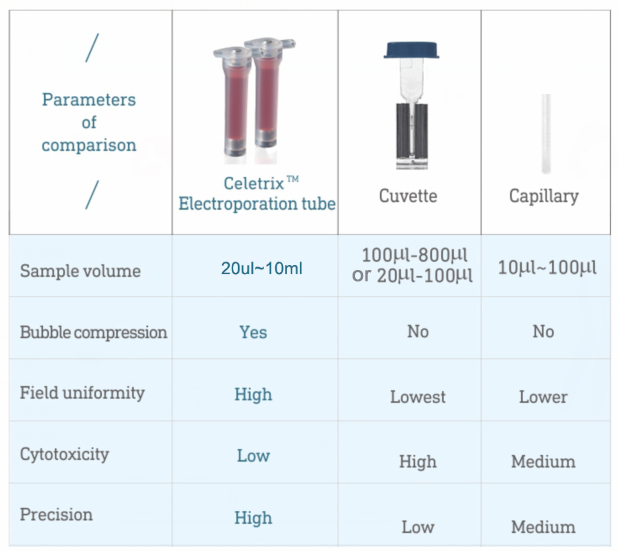- Electroporation by Celetrix
- vs Capillary
The CeletrixTM Sealed Tube
1. Limitations of capillary electroporation
 The wall of the capillary is an insulator. When a cell is very close to the capillary wall, a narrow passage between the cell and the capillary wall is formed for the electric current to pass through. This narrow passage is allocated a higher voltage because liquid resistance is inversely proportional to the cross-sectional area. The effective electroporation surface on the cell is also increased. The capillary effect (CE) can be similarly achieved in a non-capillary solution by placing cells at a high concentration allowing them to be each other’s next insulator.
The wall of the capillary is an insulator. When a cell is very close to the capillary wall, a narrow passage between the cell and the capillary wall is formed for the electric current to pass through. This narrow passage is allocated a higher voltage because liquid resistance is inversely proportional to the cross-sectional area. The effective electroporation surface on the cell is also increased. The capillary effect (CE) can be similarly achieved in a non-capillary solution by placing cells at a high concentration allowing them to be each other’s next insulator.
 The capillary effect is very sensitive to the distance between the cell and the capillary wall. When a cell is very close to the capillary wall (
The capillary effect is very sensitive to the distance between the cell and the capillary wall. When a cell is very close to the capillary wall (  Since all cells in a capillary experience the same voltage pulse from a pulse generator, it is not possible for the pulse to be equally suitable for all three areas of cells. Therefore the capillary mechanism is inherently limited.
Since all cells in a capillary experience the same voltage pulse from a pulse generator, it is not possible for the pulse to be equally suitable for all three areas of cells. Therefore the capillary mechanism is inherently limited.The limitations of capillary electrporation:
1) Help is partial and unequal, inherently unsuitable for high efficiency;
2) Air bubbles not compressed, current disturbance and arcing;
3) Small volume, inconvenient and high cost with bulk cell samples;
4) Low power pulse generator, non-scalable.
1) Help is partial and unequal, inherently unsuitable for high efficiency;
2) Air bubbles not compressed, current disturbance and arcing;
3) Small volume, inconvenient and high cost with bulk cell samples;
4) Low power pulse generator, non-scalable.
2. The Celetrix™ Sealed Tube
1>. Uniform electric field for high efficiency electroporation.
2>.Very low production of toxic agents and gas bubbles.
3>. Selection of sample volumes from small 20ul to large 10ml.
4>. Fast and cost-effective for large samples.
2>.Very low production of toxic agents and gas bubbles.
3>. Selection of sample volumes from small 20ul to large 10ml.
4>. Fast and cost-effective for large samples.
3. Advantages of Celetrix™ Tube


